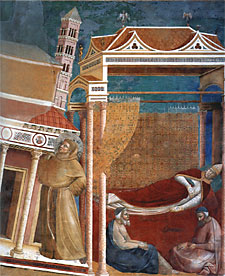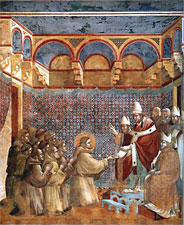St. Francis of Assisi
After their return to Assisi, the Friars Minor -- for thus Francis had names his brethren, either after the minores, or lower classes, as some think, or as others believe, with reference to the Gospel (Matthew 25:40-45), and as a perpetual reminder of their humility -- found shelter in a deserted hut at Rivo Torto in the plain below the city, but were forced to abandon this poor abode by a rough peasant who drove in his ass upon them. About 1211 they obtained a permanent foothold near Assisi, through the generosity of the Benedictines of Monte Subasio, who gave them the little chapel of St. Mary of the Angels or the Porziuncola. Adjoining this humble sanctuary, already dear to Francis, the first Franciscan convent was formed by the erection of a few small huts or cells of wattle, straw, and mud, and enclosed by a hedge. From this settlement, which became the cradle of the Franciscan Order (Caput et Mater Ordinis) and the central spot in the life of St. Francis, the Friars Minor went forth two by two exhorting the people of the surrounding country. Like children "careless of the day", they wandered from place to place singing in their joy, and calling themselves the Lord's minstrels. The wide world was their cloister; sleeping in haylofts, grottos, or church porches, they toiled with the labourers in the fields, and when none gave them work they would beg.
In a short while Francis and his companions gained an immense influence, and men of different grades of life and ways of thought flocked to the order. Among the new recruits made about this time By Francis were the famous Three Companions, who afterwards wrote his life, namely: Angelus Tancredi, a noble cavalier; Leo, the saint's secretary and confessor; and Rufinus, a cousin of St. Clare; besides Juniper, "the renowned jester of the Lord".
During the Lent of 1212, a new joy, great as it was unexpected, came to Francis. Clare, a young heiress of Assisi, moved by the saint's preaching at the church of St. George, sought him out, and begged to be allowed to embrace the new manner of life he had founded. By his advice, Clare, who was then but eighteen, secretly left her father's house on the night following Palm Sunday, and with two companions went to the Porziuncola, where the friars met her in procession, carrying lighted torches. Then Francis, having cut off her hair, clothed her in the Minorite habit and thus received her to a life of poverty, penance, and seclusion. Clare stayed provisionally with some Benedictine nuns near Assisi, until Francis could provide a suitable retreat for her, and for St. Agnes, her sister, and the other pious maidens who had joined her. He eventually established them at St. Damian's, in a dwelling adjoining the chapel he had rebuilt with his own hands, which was now given to the saint by the Benedictines as domicile for his spiritual daughters, and which thus became the first monastery of the Second Franciscan Order of Poor Ladies, now known as Poor Clares.
In the autumn of the same year (1212) Francis's burning desire for the conversion of the Saracens led him to embark for Syria, but having been shipwrecked on the coast of Slavonia, he had to return to Ancona. The following spring he devoted himself to evangelizing Central Italy. About this time (1213) Francis received from Count Orlando of Chiusi the mountain of La Verna, an isolated peak among the Tuscan Apennines, rising some 4000 feet above the valley of the Casentino, as a retreat, "especially favourable for contemplation", to which he might retire from time to time for prayer and rest. For Francis never altogether separated the contemplative from the active life, as the several hermitages associated with his memory, and the quaint regulations he wrote for those living in them bear witness. At one time, indeed, a strong desire to give himself wholly to a life of contemplation seems to have possessed the saint. During the next year (1214) Francis set out for Morocco, in another attempt to reach the infidels and, if needs be, to shed his blood for the Gospel, but while yet in Spain was overtaken by so severe an illness that he was compelled to turn back to Italy once more.
Authentic details are unfortunately lacking of Francis's journey to Spain and sojourn there. It probably took place in the winter of 1214-1215. After his return to Umbria he received several noble and learned men into his order, including his future biographer Thomas of Celano. The next eighteen months comprise, perhaps, the most obscure period of the saint's life. That he took part in the Lateran Council of 1215 may well be, but it is not certain; we know from Eccleston, however, that Francis was present at the death of Innocent II, which took place at Perugia, in July 1216. Shortly afterwards, i.e. very early in the pontificate of Honorius III, is placed the concession of the famous Porziuncola Indulgence. It is related that once, while Francis was praying at the Porziuncola, Christ appeared to him and offered him whatever favour he might desire.The salvation of souls was ever the burden of Francis's prayers,and wishing moreover, to make his beloved Porziuncola a sanctuary where many might be saved, he begged a plenary Indulgence for all who, having confessed their sins, should visit the little chapel. Our Lord acceded to this request on condition that the pope should ratify the Indulgence. Francis thereupon set out for Perugia, with Brother Masseo, to find Honorius III. The latter, notwithstanding some opposition from the Curia at such an unheard-of favour, granted the Indulgence, restricting it, however, to one day yearly. He subsequently fixed 2 August in perpetuity, as the day for gaining this Porziuncola Indulgence, commonly known in Italy as il perdono d'Assisi. Such is the traditional account. The fact that there is no record of this Indulgence in either the papal or diocesan archives and no allusion to it in the earliest biographies of Francis or other contemporary documents has led some writers to reject the whole story. This argumentum ex silentio has, however, been met by M. Paul Sabatier, who in his critical edition of the "Tractatus de Indulgentia" of Fra Bartholi has adduced all the really credible evidence in its favour. But even those who regard the granting of this Indulgence as traditionally believed to be an established fact of history, admit that its early history is uncertain.
- 3 -
- The description of St. Francis's Life in the site is short and incomplete. It gives an account of the main facts, but there are a lot of books, which open the personality of St. Francis more deeply.
- The history about St. Francis and Clare you can read in the section «St. Clare»
The dream of the Pope Innocent III
The Pope delivers the chapter











